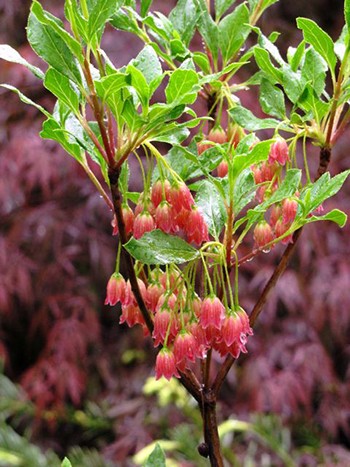Plants of the Week: June 15
Enkianthus campanulatus ‘Showy Lanterns’
Commonly called the red-veined enkianthus, this shrub is a member of the family Ericaceae making it closely related to Rhododendron. With a multitude of pendulous, pink flowers and its exciting fiery orange and scarlet autumn colors, this plant is a lovely addition to the Harry Wood Garden. The enclosed microclimate that traps and reflects sunlight makes a suitable environment for this shrub that is most comfortable in zones 7-8. The cultivar was selected for its especially dark pink flowers with red veins. photo credit: D. Mattis
Kolkwitzia amabilis ‘Ruy’s Pink’
Botanists have a way of constantly rearranging nomenclature as soon as we get used to it. This wonderful shrub known as Kolkwitzia amabilis has been purportedly changed to Linnaea amabilis, and consequently lumped into a broader classification with several other genera. It remains a member of the honeysuckle family Caprifoliaceae and is commonly called the beauty bush (amabilis from the Latin for “loveable”). The flowers of the species are usually darker pink on the outside with light pink inside, while the cultivar exhibits a light blushing pink throughout with the same golden-orange patterning on the tongue of the flower. The shrub produces long, arching branches that become dense with flowers this time of year. The flowers mature to little fuzz-balls with two projections that resemble small bird’s feet. photo credit: J. Bickel
Styrax japonicus ‘Crystal’
Native to Eastern Asia and thus commonly called the Japanese snowbell, this small tree is a member of the family Styraceae as is the commonly seen silverbell (Halesia). One specimen in particular can be found on the corner of Hicks Hall. In its glory in the early summer it produces a profusion of bright, white, pendulous flowers that emit a peculiar yet pleasant sweet fragrance. This cultivar’s flowers appear to have slightly transparent petals and darker reproductive structures. In autumn it displays intense flaming orange and yellow before shedding its leaves. photo credit: J. Bickel






![Kolkwitzia amabilis 'Ruy's Pink' JTB [7]](/wp-content/uploads/2015/06/Kolkwitzia-amabilis-Ruys-Pink-JTB-7-400x400.jpg)
![Styrax japonicus 'Crystal' JTB [2]](/wp-content/uploads/2015/06/Styrax-japonicus-Crystal-JTB-2-400x400.jpg)
No Comments